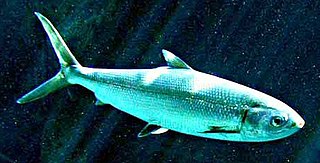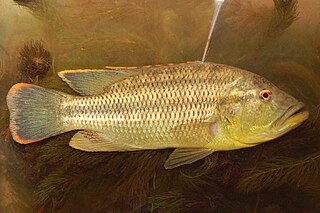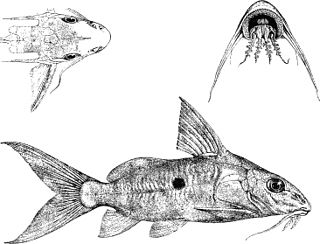
The Gonorynchiformes are an order of ray-finned fish that includes the important food source, the milkfish, and a number of lesser-known types, both marine and freshwater.

Handfish are any anglerfish within the family Brachionichthyidae, a group which comprises five genera and 14 extant species. These benthic marine fish are unusual in the way they propel themselves by walking on the sea floor rather than swimming.

Neolamprologus is a genus of cichlids endemic to eastern Africa with all but one species, Neolamprologus devosi from the Malagarasi River, occurring in Lake Tanganyika. It is the largest genus of cichlids in Lake Tanganyika and also the largest genus in the tribe Lamprologini, which includes Altolamprologus, Chalinochromis, Julidochromis, Lamprologus, Lepidiolamprologus, Telmatochromis and Variabilichromis. The latter is a monotypic genus doubtfully distinct from Neolamprologus.

Xenotilapia is a genus of cichlids species endemic to Lake Tanganyika in east Africa.

Synodontis is the largest genus of mochokid catfishes. It is the biggest genus within the 10 genera and 190 different species in the family Mochokidae. Synodontis has over 131 different species within the genus. Synodontis are also known as squeakers, due to their ability to make stridulatory sounds through their pectoral fin spines when handled or disturbed. Synodontis make a sound that sounds like squeaking by rubbing their spines together. They do this when they have been frightened or when they become angry. Synodontis may also squeak when they are taken out of the water. These catfish are small- to medium-sized fish with many species exhibiting attractive spotted markings. Some species are also known for naturally swimming belly-up, earning the name upside-down catfish. Some of these species are Synodontis contractus and Synodontis nigriventris. While some of these species are known to swim upside down, another species, Synodontis multipunctatus, is a brood parasitic cuckoo catfish,there are two other species Synodontis petricola and Synodontis grandiops are also called brood parasitic cuckoo catfish.

Haplochromis is a ray-finned fish genus in the family Cichlidae. It has been used as the default "wastebin taxon" for Pseudocrenilabrinae cichlids of the East African Rift, and as such became the "largest" fish "genus". Many of these cichlids are popular aquarium fishes; like similar Haplochromini they are known as "haplos", "happies" or "haps" among aquarium enthusiasts.

Pseudobarbus is a ray-finned fish genus in the family Cyprinidae. The type species is Burchell's redfin. The scientific name is derived from the Ancient Greek pseudes ("false") and the Latin word barbus. This genus contains some of the South African redfins. It was originally proposed as a subgenus, but has since been found worthy of recognition as a full genus.

Labeobarbus somereni, or Someren's barb, is a species of ray-finned fish in the family Cyprinidae. It is found in Burundi, Rwanda, Tanzania, and Uganda. Its natural habitat is rivers. It is not considered a threatened species by the IUCN. Local names for the fish in Rwanda include ikinanga, inkwenwe, ifurwe (Satinsyi) and urwozi (Nyabarongo).

Chiloglanis is a genus of upside-down catfishes native to Africa. These species have modified lips and barbels that form a suckermouth. They also have a naked (scaleless) body. Sexual dimorphism has been reported in Chiloglanis. The adult males of many of these species have elongate anal and caudal fins. Also, males may have an enlarged humeral process.

Marcusenius is a genus of the elephantfish group native to Africa. Its members are highly diverse in size, with the smallest species reaching less than 15 cm (6 in) and the largest more than 1 m (3.3 ft).
Parakneria is a genus of fish in the family Kneriidae, with 14 species, all of which are restricted to Africa.

Pollimyrus is a genus of elephantfishes native to Africa.

Serranochromis is a genus of relatively large, robust cichlids from freshwater habitats in mainland Southern Africa, ranging as far north as DR Congo and Tanzania, with the highest species richness in the upper Zambezi, Okavango and Congo basins. They are typically known as largemouths or, especially among fishers, breams. Serranochromis are mostly piscivores and they are important in local fisheries.
Synodontis dorsomaculatus is a species of upside-down catfish that is endemic to the Democratic Republic of the Congo where it occurs in the Lukusi and upper Lualaba Rivers and the Upemba lakes. It was first described by Max Poll in 1971. The original specimens were obtained in Kadia, Kisale, Katanga, in what is now the Democratic Republic of the Congo. The species name dorsomaculatus is derived from the word dorso, meaning "back", and the word maculatus, meaning "spotted", a reference to the dark round spots on the fish's back.

Synodontis nigromaculatus, known as the spotted squeaker, the blackspotted squeaker, or the speckled squeaker, is a species of upside-down catfish that is found widely in southern Africa. It has been identified in Angola, Botswana, the Democratic Republic of the Congo, Mozambique, Namibia, South Africa, Zambia, and Zimbabwe. It was first described by British-Belgian zoologist George Albert Boulenger in 1905, from specimens collected in Lake Bangweulu in Zambia.

Synodontis nummifer, known as the two spot synodontis, is a species of upside-down catfish native to the Congo Basin of Cameroon, the Democratic Republic of the Congo and the Republic of the Congo. It was first described by the Belgian-British zoologist George Albert Boulenger in 1899, based upon a holotype discovered in Léopoldville, Belgian Congo. The specific name "nummifer" comes from the Latin for "to bear a coin", which refers to the large spots on its sides.

The reticulate whipray or honeycomb stingray is a species of stingray in the family Dasyatidae. It inhabits coastal waters in the western Indian Ocean including the Red Sea, Natal and the Arabian Sea; also a Lessepsian transmigrant in the eastern Mediterranean. A large species reaching 2 m (6.6 ft) in width, the reticulate whipray has a diamond-shaped pectoral fin disc and an extremely long tail without fin folds. Both its common and scientific names refer to its ornate dorsal color pattern of many small, close-set dark spots or reticulations on a lighter background. However, the reticulate whipray is only one of several large spotted stingrays in the Indo-Pacific which, coupled with the variability of its coloration with age and locality, has resulted in a great deal of taxonomic confusion.

Petrocephalus is a genus of ray-finned fish in the family Mormyridae. All the fish species of this genus are endemic to Africa.

Enteromius is a genus of small to medium-sized cyprinid fish native to tropical Africa. Most species were placed in the genus Barbus.
Ziebell's handfish is a rare Australian handfish in the genus Brachiopsilus. It is known only from eastern and southern Tasmania. Ziebell's handfish may possibly be extinct, as there have been no confirmed sightings since 2007.

















